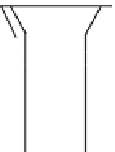Environmental Engineering Reference
In-Depth Information
Outside diameter
of sleeve
To e of sleeve
Flare
Sleeve
figure 4.13 Flared tubing end.
3. During the soldering process, do not allow the parts to move while
the solder is in a liquid state.
4. Be sure the soldering heat is adequate for the soldering job to be
done, including the types of metal and the fluxes.
5. Wash the solder work in hot water to stop later corrosive action.
4.10.3.3 Connecting Flared/Nonflared Joints
In addition to being connected by brazing or soldering, tubing can
also be connected by either
lared
or
nonflared
joints. Flaring is accom-
plished by evenly spreading the end of the tube outward, as shown in
Figure 4.13. The accuracy of the angle of flare is important; it must match
the angle of the fitting being connected. The flaring tool is inserted into
the squared end of the tubing and then hammered or impacted into the
tube a short distance, spreading the tubing end as required.
Figure 4.14 shows the resulting flared connection. The flared sec-
tion is inserted into the fitting in such a way that the flared edge of the
tube rests against the angled face of the male connector body—a sleeve
supports the tubing. The nut is tightened firmly on the male connec-
tor body, making a firm joint that will not leak, even if the tubing rup-
tures because of excess pressure. Figure 4.15 shows a flareless fitting.
The plain tube end is inserted into the body of the fitting. Notice that
there are two threaded outer sections with a
ferrule
or bushing located
between them. As the threaded members are tightened, the ferrule bites
into the tubing, making a tight connection.
4.10.4 bending Tubing
A type of tool typically used in water/wastewater maintenance
applications for bending tubing is the
hand bender
, which is nothing
more than a specifically sized, spring-type apparatus. Spring-type bend-
ers come in several different sizes (the size that fits the particular sized
tubing to be bent is used to bend it). The spring-type tubing bender is
slipped over the tubing section to be bent, then the spring and tubing
are carefully bent by hand to conform to the angle of bend desired. When
using any type of tubing bender, it is important to obtain the desired
bend without damaging (flattening, kinking, or wrinkling) the tubing. As













